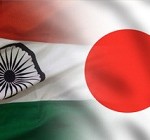India’s Prime Minister Narendra Modi will undertake his first overseas bilateral visit to Japan from August 30 to September 3. The visit is his first voyage to a country outside New Delhi’s immediate neighbourhood after taking charge. Modi’s trip, rescheduled from early June, has since been preceded by visits and meetings by officials from both sides to ensure that the bilateral meet yields some concrete deliverables. His meeting with his Japanese counterpart Shinzo Abe is thus widely expected to produce substantive and substantial progress, in the diplomatic, economic and defence realms.
The Japan-India relationship is deeply rooted in centuries-old cultural and civilisational ties, and the two democracies – also Asia’s second and third largest economies – today share a range of common interests. The bilateral witnessed a dramatic transformation in 2000 when both sides launched the India-Japan Global Partnership in the 21st Century during Japanese Prime Minister Yoshiro Mori’s landmark visit to India. It was upgraded to a Global and Strategic Partnership in 2006, and Abe – during his year-long tenure as prime minister from 2006 to 2007, put in a lot of effort to advance the bilateral.
The momentum has only increased since then with the historic state visit of the Japanese emperor and empress to India in November 2013, and Abe’s visit as chief guest at India’s Republic Day parade in 2014.
With Narendra Modi elected as prime minister, many expect the relationship to deepen as they have many commonalities to build upon. Modi enjoys a personal chemistry with Abe and is among the three people the Japanese prime minister follows on Twitter. The two leaders also have similar views on economic reform and are ardent nationalists cautious of a rising China.
Diplomatically, both leaders aim to formally establish a “two-plus-two” dialogue mechanism that will set the platform for an annual meet of the foreign and defence ministers, and will thus upgrade the discussion from their existing vice-ministerial level discussion. This agreement would make India the fifth country with which Japan has a “two-plus-two” arrangement. Currently, Japan has such a mechanism set up with the United States, Australia, Russia and France. It will also buttress the existing annual summit meetings which have occurred between the countries’ leaders in respective capitals over the past few years. In addition to meeting Abe, Modi is also expected to have a separate audience with Emperor Akihito.
The two sides are expected to ink specific bilateral agreements in the economic and business realms. Japan is already India’s fourth largest investor, and nearly 1000 Japanese companies are currently operating in India. New Delhi now wants Tokyo to ramp up its infrastructure investment to assist in India’s development through co-production projects covering ‘smart cities’, high-speed railways, and industrial corridors. Modi will look at addressing Japanese concerns in the road and rail link projects which aim to connect the north eastern states to Myanmar and beyond, and have been stuck due to bureaucratic hurdles. India is also hoping that both countries will finally be able to sign a long-delayed civil nuclear agreement, a necessary prerequisite for Japan to begin exporting nuclear reactors to India. The deal has been held up because Tokyo wants additional controls in place to assuage non-proliferation concerns at home.
In the defence realm, Abe and Modi are expected to confirm enhanced naval cooperation through coastguard exercises and joint drills between the Indian and Japanese naval forces. They may also discuss potential additional joint military exercises with other countries, given the increased momentum for enhanced trilateral defence cooperation with the U.S. as evidenced by the Malabar exercises concluded in July. More specifically, both sides are hoping to wrap up a lucrative deal for Japan to supply a fleet of ShinMaywa U.S.-2 amphibious aircraft to the Indian Navy for search and rescue operations, which could include a vital agreement on co-production. If successful, it would be the first complete defence product Tokyo has exported in nearly a half-century following the historic easing of rules on the sale of defence equipment and technology transfer in April.
Even though Modi’s visit is expected to inject more vigour into the India-Japan relationship, it will not be free of challenges in the longer term. If Modi fails to reform India’s economy, the investor-friendly glow the country currently enjoys will fade quickly. The president of the Japanese Chamber of Commerce and Industry has reportedly already written directly to Commerce Secretary Amitabh Kant calling for “urgent intervention” in areas obstructing foreign direct investment. Turning to the security domain, both sides will have to calibrate their relationship with China individually (and jointly where necessary) to ensure that they are countering Beijing’s growing assertiveness in Asia in a way that does not negatively affect their ties with other countries.
Although many Asian countries are seeking a countering force against a rising China, they still view nationalist moves like Abe’s December 2013 visit to the Yasukuni Shrine, or exclusive configurations like his “security diamond” concept, as unnecessarily destabilising.
When Abe rang up Modi in May following his election victory and invited him to visit Japan, Modi said he would like to take India-Japan ties “to newer heights”. The Tokyo visit affords him the chance to begin working towards this goal. If both sides can get past some of the familiar irritants and technicalities, they will successfully lay the groundwork for strengthening one of Asia’s most important bilateral relationships.
Prashanth Parameswaran is Adjunct Fellow at the Centre for Strategic and International Studies.
This article was exclusively written for Gateway House: Indian Council on Global Relations. You can read more exclusive content here.
For interview requests with the author, or for permission to republish, please contact outreach@gatewayhouse.in.
© Copyright 2014 Gateway House: Indian Council on Global Relations. All rights reserved. Any unauthorized copying or reproduction is strictly prohibited


